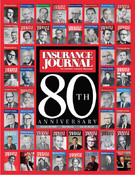U.S. insurers are likely to pay out close to $1 billion to help people whose homes, businesses and personal possessions were damaged by Hurricane Isabel, according to the Insurance Information Institute (I.I.I.). The storm, which swept across North Carolina and Virginia and created significant flooding from the District of Columbia through Pennsylvania and western New York last month, is not expected to be among the most costly in history. “Thankfully, Hurricane Isabel as a Category 2 storm did not approach the level of damage of Hurricane Floyd, which hit the same general area in 1999,” Bob Hartwig, chief economist of the I.I.I., said. “While formidable, Isabel will fall generally within the range of catastrophic risk that insurers anticipated and built into insurance premiums for homeowners and businesses along the East Coast. I would not expect the storm by itself to have a significant effect on insurance rates.” Early industry estimates, based on computer modeling and preliminary visual assessments in the affected areas, suggest that Hurricane Isabel will not rival Hurricane Floyd’s insured losses of $2 billion. However, Hurricane Isabel, together with the major tornadoes that hit the Midwest earlier in the year, makes 2003 a relatively bad year for catastrophe-related losses. According to the Insurance Services Office, insured catastrophe losses through Aug. 2003 totaled $7.6 billion compared to $5.9 billion for all of last year. Hurricane Andrew in Aug. 1992 remains the largest hurricane loss in U.S. history, costing insurers almost $20 billion (adjusted to 2002 dollars). “While the industry has the capacity to pay these claims, Hurricane Isabel substantiates what the industry has been seeing for several years,” Hartwig said. “Homeowners insurance rates in many parts of the country have been rising in large part because of the significant costs associated with these kinds of major storms. In fact, virtually every part of the country is now at risk for billion dollar disasters. But Isabel also once again proves the importance and value of homeowners insurance coverage, helping people recover from real disasters,” Hartwig added. Beyond the wind damage to homes, commercial properties and automobiles, the widespread mandatory evacuations in North Carolina and Virginia will trigger some business interruption coverage as well. At the same time, the I.I.I. cautions that while standard business and homeowners policies will cover the wind damage from Hurricane Isabel, perhaps the largest amount of property damage will result from flooding that will continue to threaten the region for a number of days. Standard policies do not cover flood damage, which is covered under policies written by the National Flood Insurance Program (NFIP), an insurance program managed by the Federal Emergency Management Agency (FEMA). According to the I.I.I., homeowners’ insurers since 1990 have paid out $1.17 in losses and expenses for every $1 they earned in premiums. In 2002 alone, homeowners’ insurers paid out $3.5 billion more in losses and expenses than they received in premiums. The I.I.I. estimates that insurance rates will rise approximately seven percent in 2003 and up to eight percent in 2004.
Topics Catastrophe Claims Flood Hurricane Homeowners
Was this article valuable?
Here are more articles you may enjoy.


 North Carolina Adjuster and Son Charged With Embezzlement in Roof Jobs
North Carolina Adjuster and Son Charged With Embezzlement in Roof Jobs  Former Congressman Charged After Collision with State Trooper in Florida
Former Congressman Charged After Collision with State Trooper in Florida  Marsh McLennan Agency to Buy Fisher Brown Bottrell for About $316M
Marsh McLennan Agency to Buy Fisher Brown Bottrell for About $316M  Trump’s Bond Insurer Tells Judge Shortfall Is ‘Inconceivable’
Trump’s Bond Insurer Tells Judge Shortfall Is ‘Inconceivable’ 


